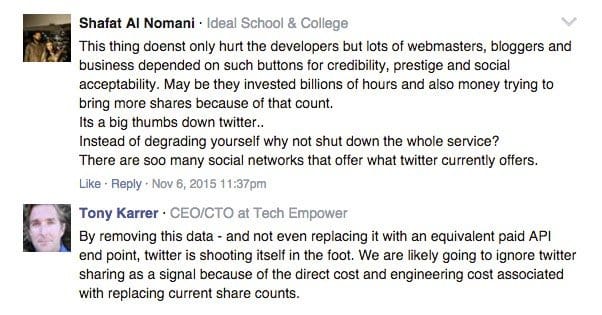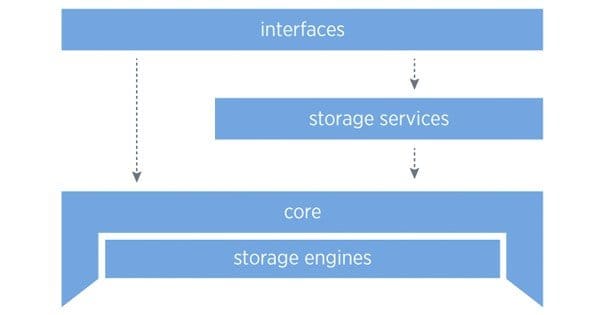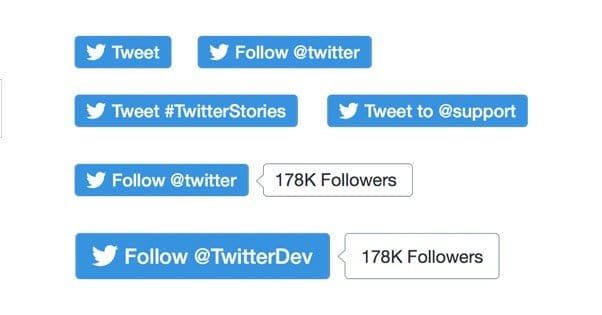 Written by ContentPowered.com
Written by ContentPowered.com
A little over a month ago, Twitter released a blog update detailing their plans to redesign the existing suite of Twitter buttons for social media. They’re changing from the typical gray with black text and blue logo, to a blue button with white text and logo. That’s a big change and affects some website designs, but it’s not the biggest announcement.
The bigger deal, and the one that is swiftly picking up steam as a Real Issue in social media circles, is the removal of the tweet count attached to the tweet button.
Just about every blog on the web has social sharing buttons attached these days. A lot of the webmasters in charge love these buttons because they allow you to display share counts for the content. A casual reader can see that the post they’re reading has hundreds of shares on Facebook, hundreds of tweets on Twitter, hundreds of +1s on Google+, and so forth. It’s all part of the ongoing trend of including social proof with your content.
Is this the beginning of the end for that trend? Will we start seeing other social networks follow suit and begin devaluing or hiding social counts? Or is this a horrible mistake that’s going to hit Twitter where it hurts and drive marketers to focus on other platforms?
Why the Count is Removed
Twitter has given some good reasons why they’re removing the tweet count from their buttons, but social media experts have added a couple more to the discussion. Let’s look at each of them.
The first reason is that the tweet count was never a truly official data source. It came from a series of undocumented and unofficial API hooks, which were never meant to be used as broadly as they have been. These hooks allowed the official Twitter tweet button to show the tweet count, but they were also co-opted by developers for making custom tweet buttons as well. Any time you see a skinned-over tweet button on a site, using a third party plugin, that button is making API calls to this undocumented data source.
This ties into the second reason Twitter gave for removing the data source, which is their development architecture. For a long time, they ran on Cassandra, more specifically Apache Cassandra, which is an open source database system. It was designed for large scale use, which Twitter undoubtedly is, and even their system began to overrun the capabilities of Cassandra.
As such, Twitter has been migrating from their past Cassandra architecture to a new system, called Manhattan. Manhattan is their own proprietary system, designed to fit their needs, which you can read about here. Manhattan performs better, is easier to operate, is more reliable, and scales better than Cassandra for the needs of Twitter.
The problem is, migrating a feature from Cassandra to Manhattan required completely re-engineering the way that feature worked. It had to function on an entirely different architecture. If you’re a developer, you know that working with multiple architectures can be very time consuming and expensive. It’s why a lot of software only works on either PC or Mac, with Linux users left to fend for themselves; developing for two platforms, let alone three, is extremely difficult. It’s generally not worth the time, money, and effort.
This brings us back to the tweet counter. The API data stream used to maintain that count is one of the last legacy features of Twitter running on Cassandra. Twitter wants to move away from Cassandra entirely, so they’re cutting out features that rely on it. Some features, more central to the operation of Twitter, were obviously redeveloped for Manhattan. The tweet count API, though, Twitter decided was too minor to warrant the development time.
In other words, it’s too expensive and too time consuming to bother migrating the tweet count feature from Cassandra to Manhattan. Twitter would rather piss off all of their marketing users by removing it than develop a new way.
A third reason Twitter gave is that the tweet count was not truly reflective of the performance of a piece of content. It would count the number of tweets made with the exact URL link to the content, but that’s all. Shortlinks not made through t.co wouldn’t count. Replies wouldn’t count. URL variants wouldn’t count. It also wouldn’t show any difference between a bot with 0 followers retweeting the content and a celebrity with 10 million followers doing the same.
The Marketer’s Perspective
There are a few “conspiracy theory” reasons why Twitter might also have removed the tweet count. These are theories that various marketers have put forth to explain the change.
The first theory is sheer laziness. What’s better than spending money? Spending no money! What’s better than spending time? Not spending time! Twitter doesn’t think the tweet count attached to their button is worth spending the time and money to redevelop for their new architecture.
A side effect of this theory is the thought that Twitter is going to stall and delay any motion to re-implement the counter, which encourages developers in the wild to figure out a way to do it themselves. Twitter could then buy or mimic the functionality, thus saving themselves a ton of development time and energy. That’s assuming, of course, that third party developers want the tweet count badly enough to invest in making their own method of reading it.
The second theory is that Twitter is trying to increase, rather than decrease, the value of the tweet count. By making the metric available privately, but difficult to obtain, they make it more potent and more valuable. Instead of just being a number that’s a given on any blog, it becomes something only the popular, lucrative blogs can implement. Chances are they would do this through their official data provider, called Gnip. Gnip provides a lot of Twitter insight and analytics data, but it’s essentially the opposite of Google Analytics. GA is free for anyone with a Google account, which itself is also free. Gnip is expensive. They don’t have public pricing data on their site, but reports range from $300 to $4,000 per month for the service. That’s a lot of money Twitter is making through the sale of a metric they used to provide for free.
A related theory is that, while pushing people towards Gnip isn’t a bad thing, Twitter is instead just trying to encourage people to use their own Insights native to Twitter. Twitter’s free insights panel is useful, but many people skip over it in favor of just using the social tweet button counter in conjunction with UTM-tracked links and insights on other sites, like Facebook.
By buffing up the data in Twitter Insights, and by making the important pieces of data hidden from an easy API, Twitter pushes people to use their Insights more. This is beneficial for Twitter, of course, plus it gives them another vector for pushing the idea of paid ads on Twitter. Again, another way for them to make some money.
The third theory is the opposite; that Twitter is trying to devalue “cheap” social metrics. They claim that the tweet count isn’t really representative of the actual spread of a link on the platform, and that’s true. By removing the count, they encourage marketers to look at more meaningful metrics.
It’s also possible that Twitter is looking towards the future and has seen that entities like Google don’t really care about the very basic social metrics, such as tweet count or Facebook likes on a post. What matters more to them is the overall performance of a piece of content, which the tweet count doesn’t accurately represent. Twitter removing this metric could be the start of a cascade of social changes, meant to minimize the basic and virtually worthless metrics while pushing attention on the more valuable metrics.
Some people even theorize it’s part of Twitter’s mobile heritage; they’re looking at mobile and even wearable tech as the way of the future, and realizing that tweet counters take up valuable space and likely will be dropped in favor of more valuable content.
The fourth theory is that the people in charge of Twitter are just being ignorant of the situation and how many people like the tweet counts. It’s always possible that they just don’t realize how widely used and widely valued the tweet count is. That could be why they pushed back the rollout of this feature from, well, right around now to late November. They could be hurriedly rethinking their decision and getting engineers to work on the migration.
The ignorance perspective is supported by some of the evidence as well. Primarily, in their explanatory blog post, Twitter claims that “few other social sharing buttons have related counts attached.” Any blogger using these buttons knows that’s not true. Facebook, LinkedIn, Google+, Pinterest; these all have counts, and many of the minor networks do as well.
Fallout from the Decision
So, with the removal of the tweet count, what’s going to happen to the blogging world at large?
There’s a lot going on with the removal of a simple number.
- Anyone using the default Twitter button with tweet count is going to have their button replace with the new design, missing the counter. If their site design includes counters with all their other social buttons, this new button will look out of place.
- Anyone using a third party plugin will have to carefully monitor how that plugin performs. Some of them, particularly the older and less supported plugins, might break entirely. Some will need updating.
- Anyone who relies on social proof to help sell their products will need to figure out a different way to represent their Twitter social proof, or remove it entirely. Follower count will still exist, as far as I know.
- Anyone who manages social media for other businesses will need to find a new way to represent Twitter success. Tweet count was a decent metric for showing growth, even if it’s not an accurate representation of the specific numbers.
- Anyone who develops a third party social plugin that benefits from tweet count as a feature will be left bereft, which can remove a crucial selling point from your product and drop sales and interest.
- It’s somewhat likely that tweet counts will drop without a visible indicator of popularity. A lot of people are more willing to retweet a link when they know a bunch of other people have before them. Without this visible knowledge, there’s a little less incentive to share.
- If any search engine was using tweet counts as a metric, even a soft metric, they will certainly not continue to do so when the data becomes basically unavailable.
- Some third party plugins are coded in such a way that they require a response from each network before displaying any counts. Some people have reported that no response from Twitter stalls out all of the rest of their social counts, making their metrics look like 0 across the board.
Needless to say, there are essentially no positives to this for the average blogger or business. If you didn’t care about Twitter before, this actually removes one potential incentive you might have had for investing in it, that being social proof. If you were invested in Twitter, at best this change doesn’t effect you, but at worst it becomes hugely detrimental. I foresee businesses dropping products and losing clients because of this change.
The only people that this benefits are the engineers who would be tasked with migrating the feature from Cassandra to Manhattan. Even then, those engineers will be working on something, right? Well, if public outcry is bad enough and Twitter’s stock prices continue to fall, it’s entirely possible that the negative pressure of this chance will put some of them out of their jobs. Even Twitter themselves stand to lose out on this decision, potentially even more than the cost of renewing the button on their new architecture. No one wins.
What Do You Think?
What are your opinions about this change? I’m interested to hear what the readers of this blog have to say about it. Conversation around the web seems to range from mild concern about what other Twitter features are going away, to a frenzy of negative backlash from the people most hurt by the change. No one seems to have an opinion any higher than slightly negative ambivalence.

Even this very blog will need to adapt. We have some fancy share buttons up at the top of our posts, and all of them have counts except the Reddit button, which doesn’t provide a counter. It’s also a bit of a blow to our business model, but there’s nothing new about that. Social networks are nothing if not fickle about their features.
All in all, I strongly suspect that either Twitter will go back on their decision in the next few months, or that some third party will come along and figure out a way to harvest the data – or a potentially more valuable, similar metric – and provide it for use in buttons. Am I right? I guess we’ll find out in the first quarter of 2016.




